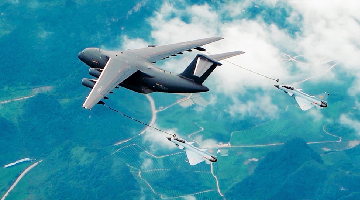By Xu Yongzhi
The Japanese cabinet passed a resolution on December 16 to officially release three vital security policy documents, including the new National Security Strategy (NSS). What’s most conspicuous about these documents is a major breakthrough and shift in Japan’s security policy, especially the development of offensive weapons, massive increase in military spending, and the intensified military integration with the US, which have caused concern and objection in many circles. On the very day of the release, hundreds of Japanese people gathered and protested in front of the prime minister’s residence, holding up boards reading “DO NOT lift the ban on counterattack capability” and “objection to the three security documents”. A Japanese anti-war organization issued a statement saying that the three documents will enable Japan to wage a war again, which is extremely dangerous.
The new NSS makes it clear that Japan will develop the so-called “counterattack capability”, which is just a euphemism used by the Japanese government to call offensive armed forces and a sophistry coined to cover up its violation of the exclusively defense-oriented strategy. Essentially, fundamentally strengthening military capacity means buying warplanes and missiles. In fact, the Japanese defense ministry has long begun to develop homemade cruise missiles (modified Type 12 surface-to-ship missiles) and hypersonic weapons. Tokyo announced in August this year that it will deploy the Type 12 missile in 2024, two years earlier than the original plan. The country is also in talks with the US about buying more than 500 Tomahawk cruise missiles with a firing range of about 1,600km.
According to the new security policy, Japan will be able to launch “attacks” if three conditions are met: Japan is under attack or its friendly country is under attack that threatens Japan’s existence; Japan has no other appropriate means to counter attacks; the use of armed forces is kept at the minimal level. America’s National Public Radio commented that counterattack capability means attacking an enemy's land, which indicates that Japan has shifted to a policy which is completely different from an exclusively defensive one. Britain’s Financial Times said the three documents marked Japan’s wild deviation from the peaceful position established by its Pacific Constitution.
The other two documents are the National Defense Strategy (NDS) and Defense Buildup Program (DBP), issued to replace the former National Defense Program Guidelines (NDPG) and Medium Term Defense Program (MTDP). The DBP proposed to increase the national defense budget to 43 trillion Yen (U.S. $315 billion) in the five years from the fiscal year of 2023, more than 1.5 times the amount between the fiscal years of 2019 and 2023.
It’s worth noting that the excuse used by the Japanese government to justify its military expansion is more severe “external threats”. What’s worse, its documents label China as its greatest strategic challenge so far and are groundlessly smearing China’s national defense construction and normal military activities. In fact, while making Japan a military power is the long-term pursuit of its right-wing conservatists, re-arming it now also suits America’s strategic interests. It is the result of the two countries’ joint efforts.
On the American side, its new National Security Strategy stresses making better use of the allies’ strengths to seek its own strategic interests. Following this principle, it has relied more on its allies either in waging an all-round strategic competition with China or in advancing the “Indo-Pacific strategy”. On Japan’s side, as it is actively seeking to become a member of the expanded Five Eyes Alliance Plus and AUKUS Plus, passing the three documents at this moment is no different from pledging allegiance. In fact, Japan has been in close communication with the US while formulating the documents. Its defense minister Yasukazu Hamada admitted that Japan and the US are aligned in their strategic direction. Japan even renamed its National Defense Program Guidelines, a title rather characteristic of Japan, to be National Defense Strategy following American reference. Next year, Fumio Kishida will visit the US to discuss with Biden the revision of the Guidelines for Japan-U.S. Defense Cooperation and the re-division of work. The joint use of new types of weapons, including the above mentioned missiles, will very likely be a key topic in the next round of “2+2” meeting between Japanese and American foreign and defense ministers.
Developing offensive weapons and being ready to exercise its “right to collective defense” for the US anytime show that the exclusively defense-oriented strategy Japan has upheld for so long has become meaningless, and the Pacific Constitution has become a shell. Japan, once following the wrong path of militarism in history, committed crimes against humanity through aggressive expansion and plunged the region and the world into unbearable suffering. Its current major shift in the security policy and reinforcement of counterattack capability is sure to bring risks and challenges to regional security without making the country any safer. On the contrary, its tendency to break away from the post-WWII track of peaceful development will definitely arouse vigilance and objection in all peace-loving people.
(The author is from China Institutes of Contemporary International Relations)









